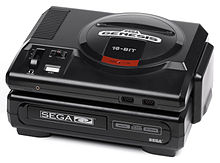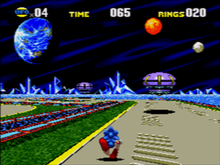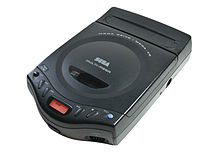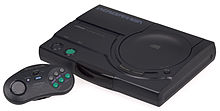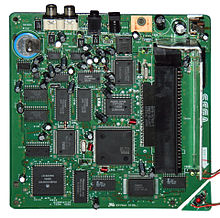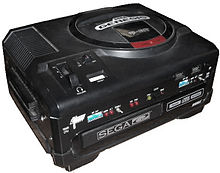- Mega-CD
-
Mega-CD 

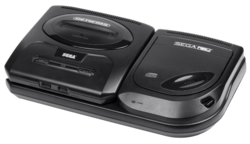
NA model 2 Sega CD and a model 2 Sega GenesisManufacturer Sega Generation Fourth generation Retail availability - NA October 15, 1992
- EU April 19, 1993
- AUS April 19, 1993
Units sold 6 million[2] Media CD-ROM, CD+G CPU MC68000 @ 12.5 MHz Storage capacity Internal RAM Related articles Sega 32X The Mega-CD (メガCD Mega Shī Dī) is an add-on device for the Mega Drive video game console, designed and produced by Sega and released in Japan, Europe, Australia, New Zealand, and South Africa. The device was also released in North America under the name Sega CD, for the Sega Genesis. The device adds a CD-ROM drive to the console, allowing the user to play CD-based games and providing additional hardware functionality. It can also play audio CDs and CD+G discs.
The development of the Mega-CD was confidential; game developers were not made aware of what exactly they were working on until the add-on was finally revealed at the Tokyo Toy Show in Japan. The Mega-CD was designed to compete with the PC Engine CD (TurboGrafx-16 CD) in Japan, which had a separate CD-ROM drive.
The first version of the Mega-CD sits underneath the Mega Drive console and loads CDs via a motorized tray. A second version places a top-loading CD-ROM drive to the right of the console and is intended primarily for use with the redesigned Sega Mega Drive 2. Both versions of the Mega-CD are compatible with the initial two versions of the Mega Drive console, but not with the Mega Drive 3 or Genesis 3.
Contents
Markets
Japan
The Mega-CD was released first in Japan on December 12, 1991.[1] By March 1994 the Mega-CD had sold 380,000 units in Japan,[3] — 11% of Japanese Mega Drive owners.
North America
The Sega CD had been announced at the Chicago CES in June 1992. The advertising boasted full-motion video clips and CD audio soundtracks, although because of the Genesis's limited color palette and limited data bandwidth, motion video was heavily dithered and usually limited to a small rectangle in the centre of the screen.
Europe
In Europe the Mega-CD was released in April 1993. 60,000 of the 70,000 Mega-CDs shipped to Europe were sold by August 1993.
Some European countries (Spain for instance), would not see a release of the original Mega-CD, but the Mega-CD 2.
Australia
The Mega-CD was released in Australia on April 19, 1993.
Brazil
The Sega CD 2 was launched in the Brazilian market at exactly the same time as the North American release. Since the original Sega CD was never released there, it was simply called "Sega CD". However, because several Mega-CD units imported from Japan were already in the market, it was informally known as "Mega-CD".[citation needed] It was manufactured locally by Tec Toy.
Reception
See also: List of Sega Mega-CD gamesSega wanted to showcase the power of the Mega-CD, however with the actual capacity of Mega Drive cartridges being small (hundreds of Mega Drive cartridges could fit on one CD), there were not many companies ready to adapt to the larger capacity of the storage medium, especially when they were hindered by the game systems' limitations.
Seeing the technology already in use for laserdisc classic arcade, and even a few titles on the PC Engine, video seemed to be the best choice at the time. So they focused on "FMV" games. Sega started off licensing and producing primarily "full motion video" games similar to earlier Laserdisc games, that were initially praised by reviewers (for example: Gamepro's "SWAT PRO" magazine initially gave Sewer Shark a perfect score, then later re-reviewed it with a much lower score as their feelings toward the system changed)[citation needed]
Eventually, most FMV games became universally panned by game reviewers, no matter which console the game was designed for.[citation needed] The Mega CD's limited 512-color palette (of which a maximum of 64 colors were displayable simultaneously), combined with the processor not being well-suited for video, resulted in grainy, dithered images running at a lower framerate and resolution in most games.[citation needed]
Another criticism of the software library was that most titles consisted of "shovelware", in which a developer takes an existing title and adds minor new content (usually a CD audio soundtrack, or video sequences) while not expanding the original game itself.[citation needed] Few titles received major changes, but two exceptions were Earthworm Jim which featured additional levels and game changes, and The Amazing Spider-Man vs. The Kingpin, which featured many changes, which drastically restructured the game, making it less linear, and adding animated cut scenes.[citation needed]
Despite a somewhat lackluster library of games, the console introduced at least one notable franchise.[citation needed] The Lunar series, despite the relatively narrow circulation the two titles on the Mega-CD received, was critically acclaimed and became a cult classic, with both games receiving remakes for the PlayStation and Sega Saturn in the late '90s; and a prequel to the series for the Nintendo DS in 2005. Another notable title was the cult-classic Snatcher, a cyberpunk digital comic released by Konami and designed by Hideo Kojima. Though Snatcher was already available on several platforms, the Mega-CD version was the only one released in English.
One exclusive game that was published for the Mega-CD is the now-famous Sonic the Hedgehog CD, or Sonic CD. Sonic CD has been praised for its visual style, superior CD sound, and an innovative time-travel mechanic, allowing players to explore four versions of each stage.[citation needed]
The Mega-CD was awarded Best New Peripheral of 1992 by Electronic Gaming Monthly.[4]
Models
The following models were released:
- Mega-CD I (Sega CD I in North America)
- Mega-CD II (Sega CD II in North America). Designed for the Mega Drive 2/2nd model Genesis (also compatible with the Mega Drive/1st model Genesis and included a special add-on for this purpose[5]) and to reduce manufacturing costs.
- JVC Wondermega RG M1 (JAPAN-ONLY (released on April 1, 1992): combination Mega Drive/Mega-CD player with enhanced sound, video and karaoke capabilities and a mechanized CD tray lid. Also included MIDI functionality. Sega themselves released on April 24, 1992 a variation of this unit with slight cosmetic changes, but functionality remains identical – Branded as Sega Wondermega)
- JVC Wondermega Model RG M2 (JAPAN-ONLY: a second model with a different case design and wireless controller functionality built in. The mechanized CD tray was omitted in favour of a more conventional spring-loaded tray design. Otherwise, functionally identical to the Wondermega I. This model was stripped down released in the US as the X'Eye.)
- Sega Multi-Mega (called Sega CDX in North America). A portable CD player that plays both Mega Drive and Mega-CD games, as well as audio CDs, and CD-G discs. Resembling a slightly longer version of the typical portable CD player of the day.
- Pioneer LaserActive Sega Mega-CD module, an add-on device available for the LaserActive system
Technical specifications
The Mega-CD specifications are as follows:[6]
CPU
The main CPU is a 12.5-MHz 16-bit Motorola 68000 processor. The Mega Drive has the same processor, but at a lower clock rate of 7.67 MHz (NTSC) / 7.61 MHz (PAL). In the combined system, both processors run concurrently for Mega-CD games, and the Mega-CD processor is idle for Mega Drive games.
Graphics
- Graphics Processor: Custom ASIC
- Number of simultaneous colors on screen: 64 out of 512
- Display resolution: 320 × 224 pixels and 256 × 224, video size from ¼ to full screen
- Cinepak video compression scheme, implemented in software
- Scaling and rotation effects
RAM
- Program RAM: 4 Mbit (upgrade from the Mega Drive's 64 kbyte)
- Word Ram: 2 Mbit, this RAM is used as a bridge for the two processors
- PCM samples: 512 kbit
- CD-ROM data cache: 128 kbit
- 64 kbit Internal Backup RAM (for storing saved games, scores, etc. for CD games)
Storage
- 500 MB CD-ROM discs (equivalent to 62 minutes of audio data)
- CD-ROM drive transfer rate: 150 kB/s (1x)
BIOS
When the Mega Drive + Mega-CD is powered on, the Mega Drive CPU gets control first. If a cartridge is inserted, the Mega Drive ROM starts it, and the Mega-CD remains idle, except for the audio mixer, which passes through the Mega Drive audio to its RCA outputs. If the cartridge slot is empty at power-up, a part of the BIOS is mapped to the Mega Drive CPU memory map and is run by the Mega Drive CPU, which decompresses other part of the BIOS onto the Mega-CD memory. Then the Mega-CD CPU runs other code of the BIOS. Both CPU run together a program which checks the disc while displaying a Mega-CD (or Sega CD) title animation with music utilizing the sound hardware of both the Mega Drive and the Mega-CD. If a game disc is inserted, it automatically loads the game after a few seconds, or immediately if Start is pressed on the controller. If a regular audio CD or a CD+G disc is inserted, it waits for button A, B, or C on the first controller to be pressed, then starts the GUI CD/CD+G player software in ROM. It will also run this software on a game disc if A, B, or C is pressed before the game auto-starts.
From the CD player, it is also possible to enter a utility to manage items in the game backup RAM and RAM carts, or to start an inserted Mega-CD game disc (without resetting the console). On all second revisions of the Mega-CD boot ROM, if the user has a Mega Mouse or Sega Mouse plugged into control port 2, this may be utilized as a pointing device instead of using a traditional control pad. If no disc is inserted, it prompts on screen for one while playing the title animation and music. Except when a game disc is in the drive, if no button is pressed at the Mega-CD title screen, the animation and music will loop indefinitely.
In the original Mega-CD model which has the motorized front-loading tray, pressing reset while the title screen is displayed will open the tray (eject the disc) or close it (load the disc). At all other times (without a cartridge inserted), pressing reset will return to the Mega-CD title screen, but will not open the tray. It is impossible to open the motorized tray with a cartridge inserted, as the BIOS which controls it will not run then. In the later version of the Mega-CD with the top-loading drive, resetting or powering off may leave the disc spinning, and the only way to stop the disc before opening the tray is to switch off the system and wait 15 to 30 seconds for it to spin down (under the light friction of the spindle motor bearings) or to enter the CD player mode and play or pause the disc, then stop (in BIOS v2.00, maybe others). After the disc can be heard to spin down while the lid is closed, whereas just pointing to Stop and pressing a button will not spin down the disc when the player is not in play or pause mode.
BIOS Revisions BIOS Version Machine 1.02 Pioneer LaserActive Mega LD 1(Japan/North America) (based on ver. 0.98 proto Mega-CD BIOS) 1.00 Original Mega-CD (Europe/Japan), Sega WonderMega 1 (Asia) Victor WonderMega RG-M1 (Asia) 1.04 Pioneer LaserActive Mega LD 2 (North America) (based on ver. 1.10 Sega-CD BIOS) 1.10 Original Sega CD (North America) 2.00 Mega-CD 2 (Europe/Japan), Sega CD 2 (North America), Victor WonderMega RG-M2 (Asia), JVC X'eye (North America) 2.11 Mega-CD 2 (Europe/Japan), Sega CD 2 (North America) 2.21 Sega Multi-Mega (Europe), Sega Genesis CDX (North America) Audio
The Mega-CD adds the Ricoh RF5C164 chip, which gives 8 extra sound channels, all capable of sampled sounds, to the Mega Drive's YM2612 and SN76489 chips (which provide a total of 18 channels, with the YM2612's 6 channels and PSG's 4). The drive did not have a board-level connection with the audio and required an additional connection to mix the sounds from the console and the drive (later version addressed this deficiency).
- Sound format: Stereo PCM
- Clock frequency of source: Up to 12 MHz
- Sound channels: 8
- Maximum sample rate: 32 kHz (44.1 kHz for CD-DA)
- Wave data width: 8 bits
- 16 bit DAC
- 8x internal over-sampling digital filter
- Frequency Range: 20 Hz – 20 kHz
- Signal-to-Noise Ratio: > 90.0 dB @ 1K
- Channel Separation: > 90.0 dB
- Output: RCA stereo Pin Jack x2 (L/R) / SCART cable
Other
- Dimensions: 301 mm × 212.5 mm × 112.5 mm
- Weight: 1.4 kg (3.1 lb)
Accessories
- Few accessories were released for the Mega-CD. The most notable being an external memory card that came in the form of a Mega Drive cartridge. Titled the "CD Backup RAM Cart", it was placed in the Mega Drive slot like a normal Mega Drive game, and the Mega-CD would detect this cartridge upon booting up. Games could either be saved directly to it (on the titles that supported it) or to copy/transfer game saves to and from the Mega-CD's internal RAM. Complete backups were possible as the CD Backup RAM Cart contained 16 times the amount of Back-Up RAM as the Mega-CD (1 Mbit, or 2045 Game Save Blocks, compared to the Mega-CD's 64Kbit, or 125 Game Save Blocks.)
- A Light gun named "The Justifier" was also released bundled with Lethal Enforcers.
- A multi-functional unlicensed cartridge called "Megacart" was released in 2006. It works as a region converter, RAM cart and can flash cart games.
References
- ^ a b "[セガハード大百科 メガCD"]. 2004. http://sega.jp/archive/segahard/mcd/. Retrieved 2008-12-22.
- ^ Blake Snow (2007-05-04). "The 10 Worst-Selling Consoles of All Time". GamePro.com. http://www.gamepro.com/gamepro/domestic/games/features/111822.shtml. Retrieved 2007-11-25.
- ^ "MEGA". Future Publishing. August 1994. p. 24.
- ^ Electronic Gaming Monthly's Buyer's Guide. 1993.
- ^ "Japanese Mega CD 2". Segagaga Domain. http://www.segagagadomain.com/hardware-mega/megacd2.htm. Retrieved 2010-08-01.
- ^ Schiller, Christian (1998-12-06). "Sega CD programming FAQ" (plain text, 7bit ascii). http://eidolon.dnsalias.net/eifiles/scdpfaq_015.txt. Retrieved 2006-09-03.
External links
- Sega-16 – Comprehensive site with hundreds of reviews and articles.
- SegaBase – Comprehensive history of this system.
- Sega-Mega-CD-Library – Collectors Guide for the PAL SEGA Mega-CD.
- Sega CD Universe – Sega CD site with reviews, photos, screen shots, cheats, and more.
Sega Sega Studios Global Entertainment · New Entertainment · Sega Sports Japan · Sega Wow · Sega AM2 · Sega AM3 · Wave Master · The Creative Assembly · Sports InteractiveConsoles SG-1000/SG-1000 II · Sega Mark III/Master System (Variations) · Genesis/Mega Drive (Variations · CD · 32X) · Saturn · DreamcastHandheld Computers Portable media players Clone consoles Sega ZoneEducational Consoles Dual system Services Accessories Light Phaser · Menacer · Activator · AX-1E · Mega Mouse · Lock-On · Sega VR · DirectLink · Dreameye · Dreamcast Broadband Adapter · Dreamcast VGA · VMU · GD-ROMRelated List of Sega video game franchises · List of Sega arcade system boards · Sega Sammy Holdings · Ota-ku, TokyoFourth generation video game consoles CD-i · Commodore CDTV · Neo Geo · Sega Mega Drive/Genesis · Super A'Can · Super Nintendo Entertainment System · TurboGrafx-163rd generation5th generationCategories:- Sega consoles
- Sega Mega Drive
- Video game console add-ons
- Fourth-generation video game consoles
- 1991 introductions
- Electronics introduced in 1992
- 1993 introductions
Wikimedia Foundation. 2010.

